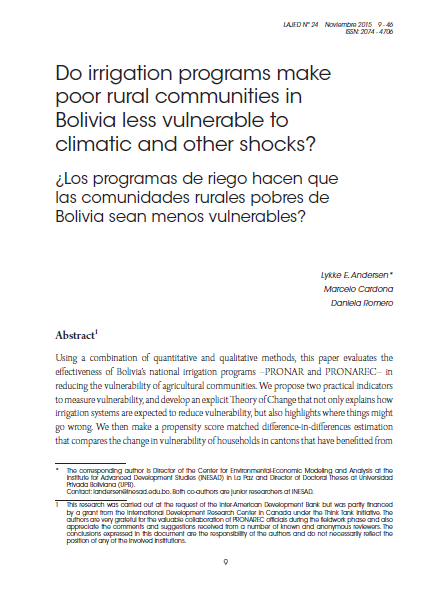Do irrigation programs make poor rural communities in Bolivia less vulnerable to climatic and other shocks?
DOI:
https://doi.org/10.35319/lajed.20152468Keywords:
Vulnerability, resilience, adaptation, irrigation, BoliviaAbstract
Using a combination of quantitative and qualitative methods, this study evaluates the effectiveness of national irrigation programs in Bolivia - PRONAR and PRONAREC - in reducing the vulnerability of farming communities. We propose two practical indicators to measure vulnerability empirically, and we develop a Theory of Change that details how irrigation could affect the vulnerability of agricultural households. We proceed to make a "propensity score matched difference-in-difference estimation," which compares changes in vulnerability among households in beneficiary cantons of a national irrigation program between 2002 and 2012 and similar households in cantons that have not benefited from irrigation programs. The quantitative analysis is complemented with a qualitative analysis based on interviews and focus groups with current and former officers, as well as beneficiaries in the highlands, valleys and lowlands of Bolivia.
Downloads
References
Adger, W.N. (1999). “Social Vulnerability to Climate Change and Extremes in Coastal Vietnam.” World Development, 27 (2): 249-269.
Andersen, L. E., M. Cardona, J. M. Gómez and O. Vargas (2014). “Water, sanitation and irrigation programs in Bolivia and Paraguay: Assessing the pathways to reduced vulnerability of the local population to climatic and other shocks.” Washington, D.C.: Inter-American Development Bank. Mimeo. May.
Andersen, L. E., T. M. T. Aston & M. Cardona (2014). “The factors and strategies that determine vulnerability and resilience.” Síntesis Nº 10, Institute for Advanced Development Studies (INESAD), La Paz, February.
Andersen, L. E. & M. Cardona (2013). “Building Resilience against Adverse Shocks: What are the determinants of vulnerability and resilience?” Development Research Working Paper Series Nº 02/2013, Institute for Advanced Development Studies, La Paz, Bolivia, June.
Andersen, L. E. & Osvaldo Nina (2007). “Geographical Constraints to Growth in Bolivia.” Development Research Working Paper Series Nº 5/2007, Institute for Advanced Development Studies, La Paz, Bolivia, March.
Becker, S. O. and A. Ichino (2002). “Estimation of average treatment effects based on propensity scores.” The Stata Journal, 2 (4): 358-377.
Béné, C., R. G. Wood, A. Newsham and M. Davies (2012). “Resilience: New Utopia or New Tyranny? Reflection about the Potentials and Limits of the Concept of Resilience in Relation to Vulnerability Reduction Programmes.” Institute of Development Studies, Working Paper Nº 405, Brighton, September.
BID (2007). “Evaluación de sistemas de riego PRONAR e identificación de lecciones aprendidas”. Ministerio del Agua, Viceministerio de Riego. La Paz.
Bolivia (2005). “Memoria: Programa Nacional de Riego (PRONAR) 1996-2005.” Cochabamba, Bolivia, 2005.
Eakin, H. (2003). “The Social Vulnerability of Irrigated Vegetable Farming Households in Central Puebla”. The Journal of Environment and Development, vol. 12: 414-429.
Ellis, F. (2000). Rural Livelihoods and Diversity in Developing Countries. New York: Oxford University Press.
Ellis, F. & H. A. Freeman (2005). Rural Livelihoods and Poverty Reduction Policies. London and New York: Routledge.
Fiszbein, M. (2013). “Agricultural Diversification and Development: Evidence from US History.” Paper presented at the 5th Bolivian Conference on Development Economics, UPSA, Santa Cruz de la Sierra, 14-15 November. Available on-line at: http://www.inesad.edu.bo/bcde2013/papers/BCDE2013-101.pdf
GrantCraft (2006). Mapping Change: Using a Theory of Change to Guide Planning and Evaluation. Available on-line at: www.grantcraft.org.
Ionescu, C., R. Klein, J. Hinkel, K. Kavi-Kumar & R. Klein (2009). “Towards a Formal Framework of Vulnerability to Climate Change.” Environmental Model Assesment, vol. 14:1-16.
IPCC (2007). “Climate Change 2007: Synthesis Report. Summary for Policy Makers.” Fourth Assessment Report of the Intergovernmental Panel on Climate Change.
Kelly, P., & W. Adger (2000). “Theory and practice in assessing vulnerability to climate change and facilitating adaptation.” Climatic Change, 47 (4):325-352.
Koren, M. and S. Tenreyro (2013). “Technological diversification.” The American Economic Review, 103 (1): 378-414.
MACA-BID-GTZ (2003). “Informe evaluación de los proyectos y sistemas de riego mejorados en Bolivia por PRONAR y otros.” La Paz, Diciembre.
Molle, F., P. Wester and P. Hirsch (2010). “River basin closure: processes, implications and responses.” Agricultural Water Management, 97 (4): 569-577.
Rosenbaum, P. and D. Rubin (1983). “The Central Role of the Propensity Score in Observational Studies for Causal Effects.” Biometrica, 70: 41-55.
Saldías, C., R. Boelens, K. Wegerich and S. Speelman (2012). “Losing the watershed focus: a look at complex community-managed irrigation systems in Bolivia.” Water International, 37 (7): 744-759.
Stern, N. (2006). “Stern Review on the Economics of Climate Change.” HM Treasury, London. http://www.hm-treasury.gov.uk/sternreview_index.htm.
Verner, D. (2010). Reducing Poverty, Protecting Livelihoods, and Building Assets in a Changing Climate: Social Implications of Climate Change in Latin America and the Caribbean. Washington, D.C.: The World Bank.
Warner, J., P. Wester and A. Bolding (2008). “Going with the flow: river basins as the natural units for water management?” Water Policy, 10 (S2): 121–138.






